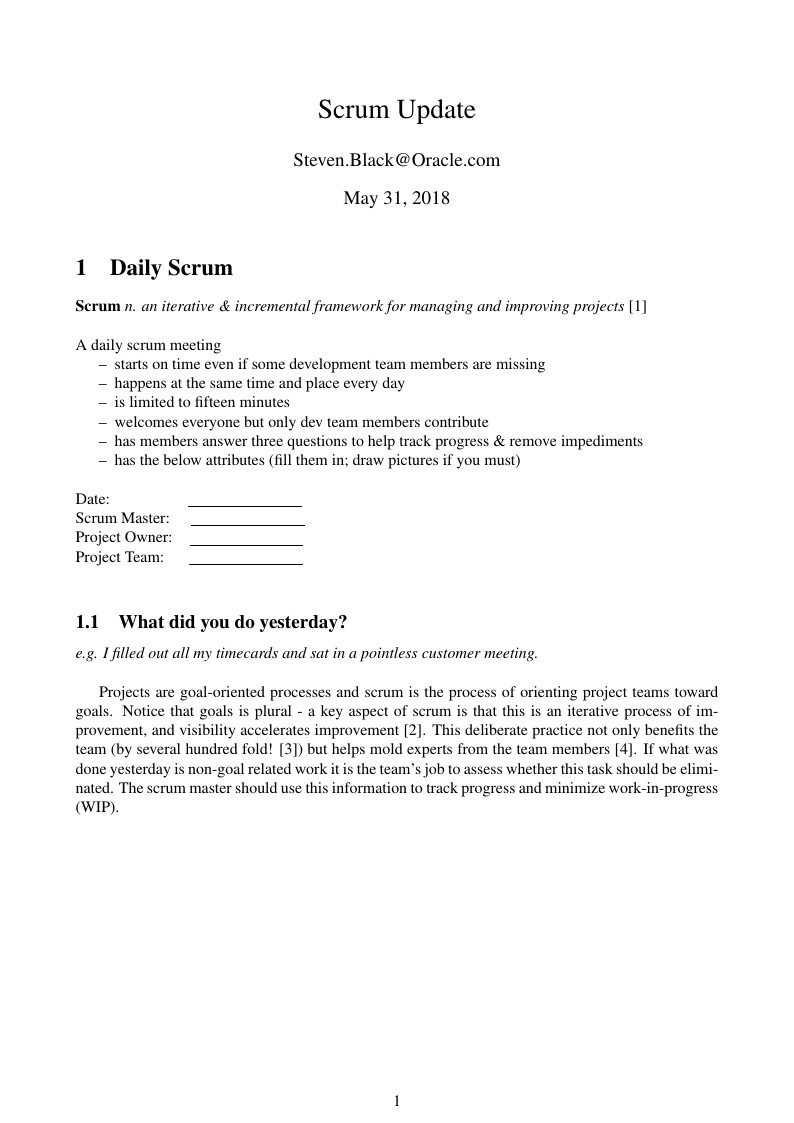
A slightly facetious worksheet for Scrum meetings.
For use with ages 1-101

\documentclass[12pt]{article}%
\usepackage{amsfonts}
\usepackage{fancyhdr}
\usepackage{comment}
\usepackage[a4paper, top=1cm, bottom=1.5cm, left=2cm, right=2cm]%
{geometry}
\usepackage{enumitem}
\usepackage{times}
\usepackage{changepage}
\usepackage{amssymb}
\usepackage{graphicx}%
\begin{document}
\title{Scrum Update}
\author{Steven.Black@Oracle.com}
\maketitle
\section{Daily Scrum}
\textbf{Scrum}
\textit{n. an iterative \& incremental framework for managing and improving projects}
[1]
\newline
\newline
A daily scrum meeting
\begin{enumerate}[nosep, label=\textendash]
\item starts on time even if some development team members are missing
\item happens at the same time and place every day
\item is limited to fifteen minutes
\item welcomes everyone but only dev team members contribute
\item has members answer three questions to help track progress \& remove impediments
\item has the below attributes (fill them in; draw pictures if you must)
\end{enumerate}
\hfill
\noindent
Date: \hspace{18mm} \underline{\hspace{3cm}}
\newline
Scrum Master: \hspace{3mm} \underline{\hspace{3cm}}
\newline
Project Owner: \hspace{2mm} \underline{\hspace{3cm}}
\newline
Project Team: \hspace{4mm} \underline{\hspace{3cm}}
\newline
\subsection{What did you do yesterday?}
\textit{e.g. I filled out all my timecards and sat in a pointless customer meeting.}
\newline
Projects are goal-oriented processes and scrum is the process of orienting project teams toward goals. Notice that goals is plural -
a key aspect of scrum is that this is an iterative process of improvement, and visibility accelerates improvement [2]. This deliberate practice not only benefits the team (by several hundred fold! [3]) but helps mold experts from the team members [4]. If what was done yesterday is non-goal related work it is the team's job to assess whether this task should be eliminated. The scrum master should use this information to track progress and minimize work-in-progress (WIP).
\vspace{5cm}
\subsection{What will you do today?}
\textit{e.g. I will demo OAC to unsuspecting victims and ponder my purpose in Larry's greater plan.}
\newline
During a project the only thing to be expected is the unexpected. Murphey's law rules.
This constant state of flux means teams must teams must reorient themselves, and scrum provides a process for this.
The scrum master should also be making sure that the tasks opened here are being closed in question one regularly [2].
\vspace{6.5cm}
\subsection{What is blocking progress?}
\textit{e.g. I have no idea what progress is so identifying blockers is like catching a black cat in the dark with no flashlight}
\newline
Occasionally project teams will see roadblocks that they cannot overcome. These impediments can be anything; pointless meetings or technical problems.
The scrum master can use this question to manage, prioritize, and assure this impediment backlog is burned down.
The Scrum team should expect management to help work the impediment backlog. Eliminating bottlenecks is the fastest way to improve productivity.
\vspace{6.5cm}
\section{References}
\hspace{3.6cm} [1]
\hspace{1mm} wikipedia.org/wiki/Scrum\_(software\_development)
\hspace{3cm} [2]
\hspace{1mm} scruminc.com/why-three-questions-in-daily-scrum/
\hspace{3cm} [3]
\hspace{1mm} scruminc.com/new-scrum-the-book/
\hspace{3cm} [4]
\hspace{1mm} hbr.org/2007/07/the-making-of-an-expert
\end{document}